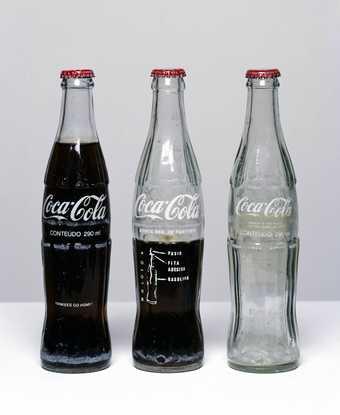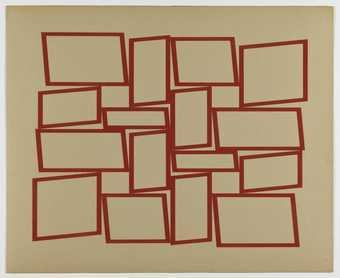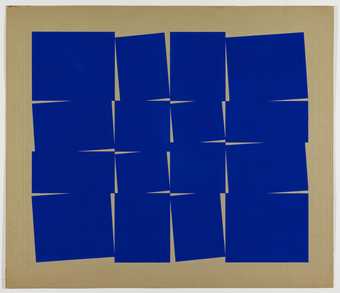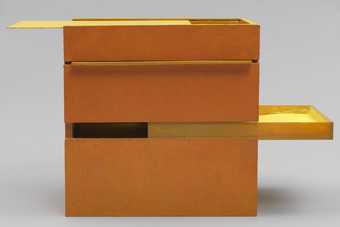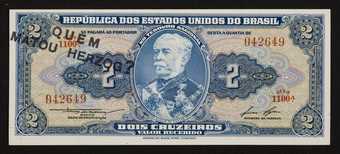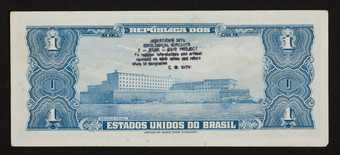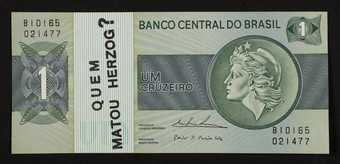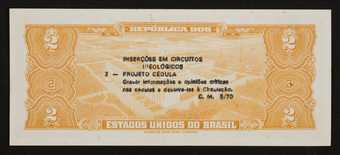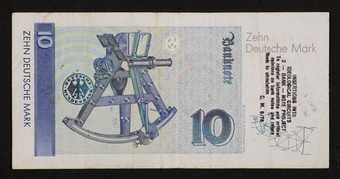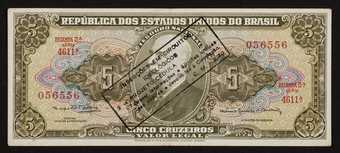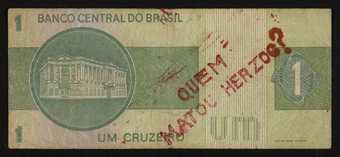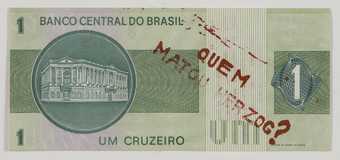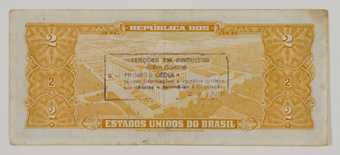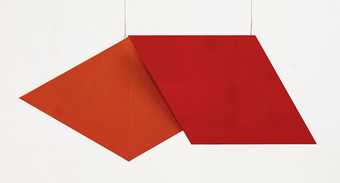
Not on display
- Artist
- Hélio Oiticica 1937–1980
- Original title
- B17 Bólide vidro 05 'Homenagem a Mondrian'
- Medium
- Glass, textile, water, pigment and cork
- Dimensions
- 300 × 475 × 600 mm
- Collection
- Tate
- Acquisition
- Purchased with assistance from the American Fund for the Tate Gallery, Tate Members and the Art Fund 2007
- Reference
- T12415
Summary
B17 Glass Bólide 5 ‘Homage to Mondrian’ 1965 is sculptural object consisting of a corked glass bottle containing a quantity of yellow liquid, which has four pieces of painted material attached to its top. The largest piece of material is a crumpled sheet of nylon mesh that has been soaked in pale blue paint and pinned to the bottle just below the cork. Two conjoined pieces of open-weave hessian, each 130 mm in width, are attached at a point near to the nylon mesh. These have been stiffened and painted yellow and orange in loose stripes, and are stitched together with cotton thread and draped so that they sit under the nylon. The smallest piece of material is a strip of cotton or synthetic lace-like mesh, which has been stiffened and painted red and is also attached near to the top of the bottle. Finally, fixed to the cork is a wad of natural fibre, possibly cotton, which has been soaked with adhesive and hardened and also has a dot of red paint on top of it. The pieces of material are arranged in a haphazard cluster around the teardrop-shaped glass form, with a gap left on one side so that the bottle can be seen through them. This vessel is mostly filled with the yellow-coloured water, and lumps of pigment and a cloudy residue have settled in the lower part of the bottle.
This work was made by the Brazilian artist Hélio Oiticica in 1965, when he was living and working in Rio de Janeiro, Brazil. It is one of a large series of works by the artist called Bólides, or ‘fireballs’, which also includes several subgroups. Although the Bólides vary in shape and size, this work belongs to the subcategory Glass Bólides, which all feature glass containers (see, for instance, B27 Glass Bólide 13 1964–5, César and Claudio Oiticica Collection, Rio de Janeiro). Both the Bólide series and the Glass Bólide subgroup were initiated by Oiticica in 1963 and all of the Bólides are titled using reference numbers, although some also have subtitles, as is the case with B17 Glass Bólide 5 ‘Homage to Mondrian’. Here, ‘B17’ denotes that this was the seventeenth Bólide work to be completed, and ‘5’ indicates that it was the fifth Glass Bólide.
The term ‘bolide’ is used in astronomy to refer to an extremely bright meteor that explodes in the atmosphere, thus resulting in a fireball. Oiticica explained the title of the Bólide series in 1979, stating that it was inspired by Brazilian director Humberto Mauro’s 1933 film Ganga Bruta (Brutal Gang):
I was attempting to paint structures in which color was a physical part of the object, in which the objects would be possessed or inflamed by color ... That’s why I used the word ‘bolide’ ... The idea came to me while I was watching Ganga Bruta, a film by Humberto Mauro in which the characters wear white and their white costumes catch and reflect the light. Mauro lit his actors ... and, as they rolled across a lawn, in this one scene, the effect was very much one of fireballs.
(Ivan Cardoso and Hélio Oiticica, ‘Ivan Cardoso Interviews Hélio Oiticica for the film “HO”’, in Roesler 2008, p.33.)
In this work, Oiticica made colour ‘a physical part of the object’ by soaking paint into fabrics and dissolving a quantity of pigment. As the conservator Wynne H. Phelan has argued, the refraction of light through the glass and water also causes the liquid’s tone to alter, highlighting the relationship between colour and luminosity (Wynne H. Phelan, ‘To Bestow a Sense of Light: Hélio Oiticica’s Experimental Process’, in Tate Modern 2007, p.100).
The subtitle ‘Homage to Mondrian’ makes reference to the Dutch painter Piet Mondrian (1872–1944), whose work provided crucial inspiration for Oiticica. In 1979 Oiticica connected the primary colours in this work with those employed by Mondrian in his later abstract paintings (see, for instance, Mondrian’s Composition with Yellow, Blue and Red 1937–42, Tate T00648), and in the same interview he also suggested that the bottle and fabrics form ‘vertical’ and ‘horizontal’ axes, which he compared with Mondrian’s frequent use of horizontal and vertical lines (Cardoso and Oiticica 2008, p.36). However, in 1960 Oiticica had claimed that his practice continued and superseded Mondrian’s project, because although the latter’s abstract paintings helped ‘representation arrive at its limit’, they remained unable to overcome what Oiticica has called ‘the metaphysics … of representation’, partly due to their ‘flatness’ (Hélio Oiticica, ‘May 1960’, in Tate Modern 2007, p.174). With its use of painted, textured fabrics and lumps of dissolved pigment, this work could be seen to stage Oititica’s project of pushing painting beyond the limits of the flat canvas.
Further reading
Hélio Oiticica: The Body of Colour, exhibition catalogue, Tate Modern, London 2007, reproduced p.282.
Silvia Roesler, Hélio Oiticica: Painting Beyond the Frame, Rio de Janeiro 2008, p.36, reproduced p.161.
Sergio Martins, ‘Hélio Oiticica: Mapping the Constructive’, Third Text, vol.24, no.4, July 2010, pp.409–22.
David Hodge
March 2015
Supported by Christie’s.
Does this text contain inaccurate information or language that you feel we should improve or change? We would like to hear from you.
Display caption
Hélio Oiticica was interested in the physical properties and structure of colour. His Glass Bólides (fireballs) consist of large glass jars or containers. Oiticica dissolved colour pigment in water. He also applied it to coarse fabric. This work is dedicated to the Dutch abstract artist Piet Mondrian (1872–1944). Mondrian’s use of reduced colours and shapes was an influence on Oiticica, who at the time also experimented with wearable garments. Oiticica was one of several Brazilian artists who exhibited at Signals gallery.
Gallery label, May 2023
Does this text contain inaccurate information or language that you feel we should improve or change? We would like to hear from you.
Explore
- abstraction(8,615)
-
- non-representational(6,161)
-
- colour(2,481)
- pigment(15)
- cloth(83)
- bottle(289)
You might like
-
Cildo Meireles Insertions into Ideological Circuits: Coca-Cola Project
1970 -
Hélio Oiticica Metaesquema
1958 -
Hélio Oiticica Metaesquema
1958 -
Hélio Oiticica B11 Box Bólide 09
1964 -
Cildo Meireles Insertions into Ideological Circuits 2: Banknote Project
1970 -
Cildo Meireles Insertions into Ideological Circuits 2: Banknote Project
1970 -
Cildo Meireles Insertions into Ideological Circuits 2: Banknote Project
1970 -
Cildo Meireles Insertions into Ideological Circuits 2: Banknote Project
1970 -
Cildo Meireles Insertions into Ideological Circuits 2: Banknote Project
1970 -
Cildo Meireles Insertions into Ideological Circuits 2: Banknote Project
1970 -
Cildo Meireles Insertions into Ideological Circuits 2: Banknote Project
1970 -
Cildo Meireles Insertions into Ideological Circuits 2: Banknote Project
1970 -
Cildo Meireles Insertions into Ideological Circuits 2: Banknote Project
1970 -
Hélio Oiticica Spatial Relief (red) REL 036
1959 -
Nelson Leirner Homage to Fontana II
1967

